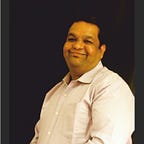Design, Dialogue, Disruption by Lourd Nathan
The perseverance to thrive in the most compelling situations is one of the unique temperaments of humans. It allows us to not only survive some of the most bizarre challenges but also evolve opportunities and create extraordinary solutions. The same results in our growth as a society and leads us to experience the profound effect it has on our lifestyle. Innovation has driven us a long way from addressing needs to the present scenario of invoicing convenience with its existence in various aspects. The shift in the demand for something even better with every product or service comes with the challenge of simplification; while providing the users with the whole package of experience.
In our fifth episode of the podcast, I had a conversation with Lourd Nathan, who leads as the Design Director at Frog Design. He takes us through his journey on how he has witnessed the landscape of the evolution of the human lifestyle, which eventually led to the transformation of basic needs to greater experiences, which affects the mental model of an individual daily subconsciously.
Rohit Lalwani: Right from the early man picking up sticks to make fire, to now creating these multidimensional experiences. I think, as a race, we’ve come a long way. What do you think about the institution of experience design?
Is it deeply rooted in us as human beings, or is it just a bonus that we got evolved into?
Lourd: Yes, I think it is rooted in human beings. We have always been service-oriented with each other. I remember Gandhi Ji’s word; the customer is the King. It gives us a hint; how can we create an experience for others? How can we make sure customers revisit us and provide word of mouth? I don’t think experience design is new.
We need to keep reminding our colleagues, clients to incorporate sound design principles. And remember from there, for whom you’re creating products and what kind of service they need? It does not just evolve now, but it has been with us for ages.
Rohit Lalwani: There’s been a recent debate that including demographic data in personas is harmful. It says that they are just stereotypes of how people have behaved. What do you think about it?
Lourd: Alan Cooper was the first to bring the concept of design personas. We used to create a fake person to give life to our design work; we utilize this person to make sure we have some informed decisions. I don’t think it is a good idea to use a lot of demographic data in persona.
At frog, what we prefer to do is the use of archetypes more, which describes target groups based on common attitudes, behaviors, expectations, and being points. These profiles help the team to uncover some of the potential opportunity areas for addressing the needs of customer goods. I don’t go with the demographic data, which is not essential for personas.
Rohit Lalwani: Is there any other better approach to creating personas apart from what you mentioned of using it in the frog?
Lourd: I feel some simple steps for creating personalized personas are having a catchy name and a nice tagline.
You need to describe the life situations, define the expectations, capture some of their habits, find a code that describes the essential thing the persona should convey.
I don’t see many designers using persona in the design process. We create one persona, two personas just for the part of the process, and move on. It is essential to take a persona to the next level.
I think taking a good printout of your persona is putting it on your desk, work areas, or maybe the discussion rooms. We need to see them every day. Remember that you’re creating a product, designs, services for them. We need to become like a detective, gathering as much information possible about this person that you’re working for.
One other thing is, the persona details should always be given to the development team. The development team should have a persona, pictures, and posters in their work area. They also need to know everything about the person whom they are developing for either admin, user, or is it like an eCommerce user for whom they are developing? And they need to picture those people. It’s essential, not just for designers, even for the development team.
Rohit Lalwani: Do you believe that experience design should be separated from interface design? Is it time to break the UI and the UX?
Lourd: In the current trends, we don’t differentiate UX designers or visual designers. At frog, we are working to make sure our designers, product designers both focused on user experience as well as visual design. We are also getting elements of design technologists who focus on the UI. So it is essential to be able to shape the entire product requirement and not just a part of it. So young designers like to work whoever is coming as freshers and, learning a lot and coming in, they want to work on both UX and VD.
And they’re eager to work on these kinds of projects as the entire chunk of work and not bits and pieces. I think we should not differentiate, but support and encourage designers to work on the whole city.
That is nothing like a UX is more significant, or VD is lesser important, or UI is less. So everything is connected. I want to coin a word as a designer, rather than UI/UX.
If you don’t want to miss out more on how these two domains, technology, and design, are collaborating, head to our podcast to discover more. For details, do visit the profile.
